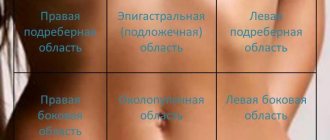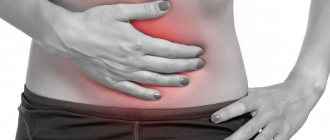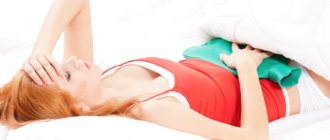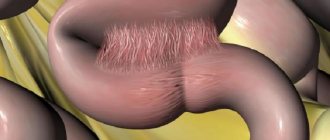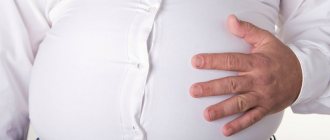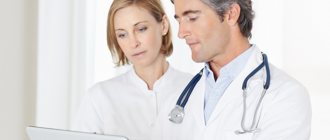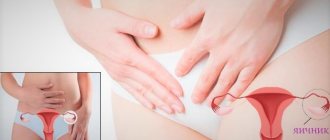Tablets for abdominal pain: a choice of painkillers and auxiliaries
There is no miracle pill that can save you from any pain attack in the abdominal cavity. It is necessary to select tablets for abdominal pain, taking into account the causative factor, recommendations of specialists and manufacturers of the product. The intensity of the unpleasant sensation can vary, as can its consequences. Drugs from several therapeutic groups taken in combination will help.
Symptoms
Acute pain in the lower abdomen or other area of the anterior wall of the abdominal cavity in most situations is the first, but far from the only clinical manifestation. It is extremely rare that such pain sensations are single and periodic in nature.
Against the background of the main symptom, a large number of other symptoms arise, which are dictated by the etiological factor. Clinicians identify a number of symptoms that almost always accompany pain in the abdominal area.
Additional signs include:
- pallor of the skin - children experience bluish skin;
- lack of gas discharge or, conversely, increased gas formation;
- stool disorder - patients often complain of abdominal pain and diarrhea, but constipation may also occur;
- increased breathing rate and heart rate;
- fluctuations in blood pressure and temperature;
- constant nausea with bouts of vomiting;
- forced body position - to reduce the intensity of pain, often knee-elbow or “fetal position”;
- release of large amounts of cold sweat;
- problems with emptying the bladder;
- severe weakness and fatigue;
- pain and discomfort during urine emission;
- attacks of severe dizziness;
- belching and bitter taste in the mouth;
- heartburn and shortness of breath;
- bloating;
- the appearance of a characteristic rumbling sound;
- disruption of the menstrual cycle;
- pathological discharge from the vagina or urethra;
- delayed or premature ejaculation;
- attacks of loss of consciousness;
- lack of appetite and weight loss;
- decreased performance;
- pain shock.
The symptomatic picture, as well as the reasons for abdominal pain, applies to both adult patients and children.
A painful attack occurred at home or at work - what to do?
Abdominal pain is usually associated with eating poor quality food and disorders of the gastrointestinal tract (GIT). Even strong emotions provoke discomfort. In such situations, stomach medicine is taken along with sedatives. Common causes of discomfort in the upper abdominal cavity are overeating and incompatible foods. In gastrointestinal pathologies, painful attacks have different localization and intensity.
Many people do not go to the doctor and take stomach pills to quickly eliminate discomfort. Even the most devoted proponents of traditional medicine admit that drugs work faster than herbs and natural products. In addition, the analgesic effect of folk remedies is often temporary.
Important! According to doctors, paracetamol has long been considered the safest and most effective analgesic for children. However, now they are no longer so sure of this. It should be borne in mind that small doses of the drug have a weak analgesic effect. With increasing dosages, paracetamol can cause nausea and vomiting, and liver inflammation.
The complex of symptoms united by the term “acute abdomen” is characterized not only by pain of varying intensity. Tension of the abdominal wall occurs, and vomiting often begins. Acute appendicitis is not treated with “regular” stomach remedies and painkillers in pill form. In acute conditions and injuries to the abdominal organs, you should not hesitate to call emergency help.
Diagnostics
To carry out treatment, it is necessary to establish the cause of colic. Since the symptoms of different diseases are similar, you need to undergo a full examination.
Anamnesis is important for diagnosis: the presence of chronic diseases, hereditary predisposition, possible connection with hazardous production, contact with patients with intestinal infection. The doctor analyzes complaints, examines and palpates the abdomen. Determines the level of tension in the abdominal muscles, pain response, skin condition, and absence of rash.
The patient needs to briefly and clearly formulate the nature of the pain, its location and other symptoms present.
The doctor prescribes the following examinations:
- general and biochemical blood test;
- Analysis of urine;
- feces for occult blood;
- coprogram;
- instrumental studies.
Gastroduodenoscopy and ultrasound can detect diseases of the abdominal organs.
To examine the rectum and part of the sigmoid colon, sigmoidoscopy is performed. Using an endoscope, damage and ulcers of the intestinal walls and fecal stones are detected.
Colonoscopy is used to visually examine the entire intestine. Any pathological changes are detected.
Computed tomography is performed if injury or tumor processes are suspected.
Remedies for stomach pain in acute gastritis
Inflammation of the gastric mucosa is accompanied by nausea, belching of rotten contents, vomiting, and diarrhea. Heaviness and pain appear in the epigastric region. The course is rapid, but the disease usually lasts no more than 5 days.
Tablets for abdominal pain caused by gastritis:
- Omez is a drug for heartburn, nausea, pain, and vomiting.
- No-spa is an antispasmodic agent.
- Activated carbon is an adsorbent.
- Plantaglucide is a herbal preparation, non-narcotic analgesic, anti-inflammatory agent.
In the first days, you must refuse to eat and stay in bed. Recommended procedures: gastric lavage with soda solution and cleansing enema.
Tablets for chronic gastritis
With a long-term inflammatory process in the gastric mucosa, dull, aching pain appears in the epigastric region. Chronic gastritis with high acidity is characterized by persistent, painful heartburn. Secretory insufficiency is manifested by nausea, belching of food, vomiting, and diarrhea.
Important! Dyspeptic symptoms caused by the intake of certain foods occur immediately or after a certain time after eating.
List of tablets for abdominal pain with chronic gastritis:
- Halidor is an antispasmodic.
- Escape is an antiulcer, antiseptic drug.
- Gastracid is an adsorbent, enveloping agent.
- Rabeloc is a drug used to suppress excess acid production in the stomach.
- Probifor is an immunomodulator, a means for normalizing intestinal microflora.
- Gastrofarm is a medicine for pain, heartburn, a probiotic remedy.
- Festal is an enzyme preparation.
If during diagnostics the patient is diagnosed with Helicobacter pylori bacteria, then antibacterial therapy is prescribed. Penicillins, cephalosporins, sulfonamides, quinolones are used for eradication - getting rid of an infectious agent. Trade names of drugs: Amoxicillin, Metronidazole, Cedex, Phthalazole.
Remedies for eliminating biliary colic
An attack in diseases of the liver and pancreas lasts from several minutes to several days. Body temperature often rises, nausea, bloating, and vomiting appear. Unbearable pain due to stones in the bile duct first occurs in the right hypochondrium, then spreads throughout the abdomen.
What pills to take for biliary colic:
- No-shpa forte, Drotaverin, Halidor, Spasmol, Spasmonet - remedies for abdominal cramps (antispasmodics).
- Pentalgin, Spazmalgon - anti-inflammatory and painkillers.
- Grinterol, Urosan, Ursodez are bile preparations, hepatoprotectors.
- Ursofalk is a remedy for the prevention of stone formation.
- Enterosan is an enzyme preparation to improve digestion.
Attacks of biliary colic may be rare, but without treatment and inattention to diet, the stomach hurts weekly. X-ray studies and ultrasound will show the presence of stones in the gall bladder.
Pain relief for pancreatitis
The inflammatory disease occurs with disruption of the secretory and hormonal activity of the pancreas. Sharp pain in the left side in front of the hypochondrium radiates to the upper abdomen, sometimes to the right hypochondrium. Discomfort occurs after eating fatty foods or drinking alcohol. Often the attack is accompanied by vomiting.
Chronic pancreatitis is the outcome of the acute form of this disease. Acute pancreatitis is treated in a hospital: antispasmodics, pain medications, medications to overcome intoxication, and normalize the acid-base balance in the gastrointestinal tract are administered. If conservative treatment fails, part of the pancreas may need to be removed.
In case of exacerbation of chronic pancreatitis, you should ease the load on the gastrointestinal tract and adhere to a diet. For abdominal pain, take Almagel A suspension, Omeprazole tablets, No-shpa forte. Hermital. Probifor and Bifidumbacterin are suitable for normalizing intestinal microflora. After the pain subsides, they switch to enzyme preparations Enterosan, Creon, Mezim, Festal,
What to take for pain in the intestines?
Unpleasant sensations in the navel area, above or below the waist are characteristic of gastroenteritis, enteritis, enterocolitis and diverticulitis. A combined medicine for intestinal pain, Meteospasmil, simultaneously eliminates spasms and bloating. Such combination drugs are in the minority on pharmacy shelves. Another option is to take several over-the-counter remedies.
Tablets for spasms and pain in the intestines (antispasmodics):
It happens that antispasmodic tablets do not help and cannot cope with severe abdominal pain. Then these drugs are taken together with the drug Spazmalgon and the liquid herbal remedy Romazulan. Pain and tension in the abdominal cavity are often combined with increased gas formation and colic in the intestines. The carminatives Espumisan and Sab Simplex cope with these symptoms. If a child has a stomach ache, it is better to give the so-called children's dosage forms - drops or suspension for oral administration.
Cervicitis
Cervicitis is a disease that leads to severe inflammation of the cervical canal. The cervix is a natural barrier that prevents pathogens from entering the woman’s reproductive system. In some cases, for example, when the mucous membranes are damaged, microorganisms enter the tissue of the cervical canal and provoke the development of infection.
There are two types of cervicitis:
- Exocervicitis is inflammation of the outer segment of the cervix.
- Endocervicitis is a lesion of the inner mucous layer of the cervical canal.
Inflammation of the cervix from the inside
A patient suffering from cervicitis has the following complaints:
- cutting pain in the lower abdomen and vagina;
- discomfort in the lumbar region;
- itching in the genital tract;
- increased discomfort when urinating or during sexual intercourse;
- the appearance of bloody discharge from the vagina after coitus;
- petechiae on the mucous membrane of the genital organs;
- unpleasant odor from the vagina.
Attention! Often recurrent chronic cervicitis provokes hyperplasia of cervical tissue, the development of erosion and the spread of the pathological process to the body of the uterus and fallopian tubes.
Video: Cervicitis in women
Depending on the type of infectious agent, patients are prescribed antibacterial or antiviral agents: Valtrex, Acyclovir, Ofloxacin , etc. After stopping the acute inflammatory process, local treatment of the pathology is carried out: the genital tract is treated with a 3% solution of dimethyl sulfoxide or 1-2% solution of chlorophyllipt .
If the cause of abdominal pain is worms
To get rid of intestinal parasites at home, medications and folk remedies are used. Tablets with the active ingredient Albendazole have a wide spectrum of anthelmintic activity: Zentel, Nemozol, Vormil. The same drugs are used to treat giardiasis. Giardia is a microscopic parasite that spreads from the intestines to other organs through the bloodstream. Painful conditions are caused mainly in children; for adults they are almost not dangerous.
Folk remedies for eliminating worms:
- fresh garlic and infusion of cloves;
- infusion of tansy flowers;
- pumpkin seeds;
- wormwood decoction.
Read more about other means here.
Pumpkin seeds and garlic are consumed internally, decoctions of wormwood and tansy are used mainly for sitz baths and cleansing enemas. Folk remedies act more gently and are safer for the human body compared to chemicals. Unfortunately, treatment is long and not always successful.
Treatment methods
It is necessary to remember the main rule: you cannot independently select therapy to eliminate gynecological ailments - this can lead to infertility.
The specialist prescribes a course of treatment based on the tests obtained. Depending on the gynecological disease, the characteristics of the female microflora, immunity indicators, possible allergic reactions, the woman is given a course of therapy based on:
- antibiotics (mandatory);
Most often, antibiotics of different groups are used for treatment
Vitamin complexes will help in treatment
Types of hormonal drugs
If a malignant neoplasm or cystic neoplasm is confirmed, surgical treatment is indicated.
Malignant tumors can only be removed surgically
Do not forget that a woman’s reproductive system is directly connected to the urinary canals, so when infected, both systems become infected. To prevent serious consequences, the following is prescribed:
- antibiotic therapy supported by sulfonamides;
- painkillers (for example, No-Shpa);
“No-Spa” is an effective antispasmodic
You need to drink enough fluids
Reference! When antibacterial drugs are powerless, treatment with fluoroquinolones is necessary. These are broad-spectrum drugs. The active substances in the drug suppress pathogenic flora, and, at the same time, do not affect the beneficial bacteria of the body. The toxic effect on the body is minimal.
General recommendations for a woman include a diet based on vegetables and dairy products, complete rest throughout the entire treatment. Find out what causes a girl's stomach pain by following the link.
Remedies for pain before and during menstruation
Often, a painful condition before menstruation is observed in women with gynecological problems, diseases of the cardiovascular system and gastrointestinal tract. Most often, the lower abdomen hurts during menstruation due to hormone imbalance and kidney disease. If the cause of discomfort during menstruation is diseases of the female genital area and excretory organs, then the effect of painkillers will be short-lived.
Important! You can take non-steroidal anti-inflammatory drugs (NSAIDs) 2-3 days before your period begins.
Baralgin and Piroxicam are produced in tablet form. For pain and abdominal cramps during menstruation, you can use rectal suppositories and tablets: Cefekon N, Diclofenac, Naproxen. Exacerbation of stomach diseases is a contraindication for the use of NSAIDs. Drugs in this group act on the gastrointestinal mucosa. After taking the pills, you may experience abdominal pain and nausea. If you take it in a short course and do not exceed the dosage, the negative effect on the gastrointestinal tract will be minimal. The optimal duration of taking NSAIDs is from 3 to 5 days.
Another group of medications helps with PMS. These are antispasmodics: No-shpa, Papaverine, Galidor, Spazmalgon, Spazgan Neo. The last two drugs and Naproxen are combined anti-inflammatory, analgesic and antispasmodic agents. They are less dangerous for the gastric mucosa because they contain less NSAIDs compared to individual medications. The effect is achieved due to the mutual reinforcement of the components.
Treatment at home is aimed at relieving unpleasant symptoms. Before using any medicine, you should read the instructions for it and find out what restrictions exist on the use of the product. If painkillers in combination with other drugs do not help within a few days, then you need to consult a specialist.
Each type of abdominal pain has distinctive features that must be taken into account when choosing treatment. The most adequate therapy is that recommended by a doctor based on an analysis of symptoms and examination of the patient.
Work experience more than 7 years.
Professional skills: diagnosis and treatment of diseases of the gastrointestinal tract and biliary system.
What to do if symptoms are present
If a woman has pain in her lower abdomen for a long time, she should consult a doctor. He will examine the patient, study all the features of the body, and palpate the stomach with his fingers.
If a man comes to the appointment, then usually his testicles and penis are examined, if a woman, then the doctor examines the pelvic area. This allows you to understand whether the lower abdomen hurts due to the uterus, ovaries, and fallopian tubes.
When to see a doctor
You should visit a specialist if the following symptoms appear:
- the duration of pain is more than 6 hours without a break, high intensity;
- in case of sharp pain in the lower abdomen on the right;
- if your stomach hurts after eating;
- if the pain is very strong, appetite disappears;
- when experiencing pain, a person vomits several times in a row;
- if pain in the lower abdomen occurs in pregnant women;
- in case of increased pain when changing body position;
- when the stomach hurts at the navel, then movement occurs. If pain is felt in the lower right quadrant, this may indicate appendicitis;
- if sleep is interrupted due to pain;
- pain ends in bleeding (in pregnant women);
- if in addition to pain there is a high temperature;
- if it is painful for a person to release gases, as well as during bowel movements and urination;
- if there is any kind of pain in the abdomen on the right, which differs from the usual discomfort in the stomach area.
It is best to visit a doctor if your stomach hurts for a week. Then you can avoid serious consequences.
When urgent medical attention is needed
You should call an ambulance as soon as possible in the following situations:
- if your stomach hurts badly and this leads to loss of consciousness and inability to breathe. This is typical for diseases such as liver failure, acute pancreatitis, abdominal bleeding;
- if the stomach hurts badly, a fever appears and the person is unable to move;
- painful sensations in the abdominal area lead to vomiting for several hours or vomiting blood;
- if the intestines do not work for several days due to acute pain. This may indicate obstruction of the digestive tract;
- if bleeding has started from the rectum. If the pain in the lower abdomen is acute, then a person may develop hemorrhagic gastropathy and intestinal ischemia. In the case of a chronic disease, abdominal pain with simultaneous bleeding indicates cancer;
- a person may have pain in the abdomen, chest, but he is not entirely sure of its placement. In such cases, heart disease often occurs;
- Men have stomach pain (groin area). This may indicate testicular torsion. If left untreated, tissue necrosis is possible.
Treatment of abdominal pain
If your stomach hurts, doctors can use two treatment methods - surgery or a conservative method. Sometimes it is necessary to undergo surgery (appendicitis, intestinal obstruction) to save a life. At JSC "Medicine" (clinic of Academician Roitberg), you can undergo effective treatment in a hospital; for this, visit the page.
The most important thing is to visit a specialist on time. He will study the whole picture and prescribe the necessary treatment. If it hurts in the front of the abdomen, tests are taken and all the research is done. Based on this, a diagnosis is already made.
Abdominal pain during pregnancy
If the symptoms listed above are absent, then heaviness in the abdomen and pain may indicate other causes. Pain in the lower abdomen may occur during pregnancy in women who are in the first trimester. This happens as the uterus grows and blood circulation increases. If a woman is pregnant, but the term is later, then abdominal pain may be associated with the fact that the baby’s weight has increased. Such sensations inside the abdomen can also occur as a result of stretching of the pelvic floor muscles, pressure on the rectum and bladder from the side of the uterus.
However, if your stomach hurts with nagging pain, you feel heaviness, but you also have vaginal discharge, spasms, pain, then you should definitely go to a specialist. Such symptoms can prevent premature birth, ectopic pregnancy, and miscarriage.
During pregnancy, your stomach may hurt due to diastasis. The growing uterus puts pressure and causes the abdominal muscles to separate. In most cases there is no pain, but sometimes there is pain in the back and navel. You don't need a doctor's help here. Almost always everything returns to normal after childbirth is over.
Treatment at home
Everything is quite simple here; you can use some methods when there is pain in the lower abdomen:
- eat prunes if you have pain in your lower abdomen. You can also take any product that contains a lot of dietary fiber (broccoli, bran). Prunes are especially useful in such situations because they contain sorbitol (a laxative of natural origin);
- Drink tea made from ginger, chamomile or peppermint. Such herbs reduce nausea and help with abdominal pain. With the help of ginger you can normalize digestion, chamomile and mint will help relieve muscle spasms;
- Use baking soda and prepare an aqueous solution. Baking soda is found in most antacid medications. It is worth taking 1 tbsp. baking soda and dilute with warm water (1 cup);
- Get a massage if your stomach hurts during your period. Spasms may occur inside due to the muscles being too tense. You will need a light massage, you need to focus on the place where it hurts the most;
- take a bath with hot water. Water will relax muscles, improve blood circulation, and relieve pain. You need to lie down for about 20 minutes. If a woman has a stomach ache, you can throw Epsom salts into the bath.
Drugs for pain relief, regardless of its cause
If you cannot determine the nature of the pain, you can use:
- No-shpa. This is an antispasmodic drug that is used to relieve spasms of the biliary tract and bladder. Can help with stomach and duodenal ulcers, irritable bowel syndrome and pain during menstruation.
- Galidor. Antispasmodic with a strong vasodilator effect. It also helps with pain that is directly related to blood vessels. And also for gastroenteritis, ulcers, diseases of the large intestine, problems with the bladder. It is a prescription drug.
- Duspatalin. Antispasmodic of the modern generation. More suitable for relieving cramps throughout the entire bowel, even if associated with diarrhea or any change in stool consistency. It has a lesser effect on the stomach.
- Spasmalgon. A universal remedy with a combined composition: 2 antispasmodics and an anesthetic. Can be taken for almost any pain. If in some situations antispasmodic components do not help, a non-narcotic analgesic is used.
- Pentalgin. The composition includes 5 active ingredients that complement each other and allow you to cope with almost any pain. It has anti-inflammatory, analgesic, antispasmodic effects. The composition contains an h1-histamine blocker, which enhances the effect of other components, in addition it has a sedative effect. Use for erosive damage to the gastrointestinal tract during an exacerbation is undesirable, but if nothing else is at hand, it can be used once in the smallest dosage.
Taking pills depending on the situation
Although there are universal remedies, it is best to try to determine the nature of the pain so that the selected tablets help fully.
If the painful sensations are constant, then you should not suppress them with analgesics, but identify and eliminate the cause.
For painful menstruation
For some women, the first days of the cycle are accompanied by severe pain in the lower abdomen, associated with uterine contractions during menstruation and hormonal changes. It is best to use antispasmodics if the pain is moderate, or combined drugs if the first group of drugs does not cope with its task.
Tablets that are best used during menstrual periods:
In particularly severe cases, some are helped only by drugs based on ketorolac or nimesulide:
They are much more powerful than other means, but also more dangerous if used uncontrolled and for a long time. It is advisable that these drugs be prescribed by a doctor, since they have a bad effect on the gastrointestinal tract and are prescription drugs.
When overeating
Acute pain in the stomach is associated with stretching of its walls. In addition to pain, nausea, a feeling of fullness, belching, and gas formation usually occur. Painful sensations may also be due to the fact that the stomach begins to compress neighboring organs.
Drugs that eliminate all of the above symptoms:
You can use enzyme preparations that help speed up digestion, as a result of which the pain goes away faster:
It is best to take these tablets during meals or immediately after, without waiting for symptoms to occur.
In case of poisoning
When pain is accompanied by diarrhea and intestinal spasms, it is recommended to take antispasmodic drugs, which additionally affect the restoration of stool, normalizing intestinal motility:
If nausea and vomiting are present, you can take drugs based on domperidone or metoclopramide:
They should be taken with a small amount of water to avoid vomiting. It is preferable to choose Motilium in the form of soluble tablets.
For gastritis
Antacids are best for relieving pain due to erosive gastrointestinal lesions. They coat the esophagus and stomach, soothe the mucous membrane and neutralize acid. But they are only a short-term solution to the problem, they are used as a temporary measure:
A significant disadvantage of such drugs is the “rebound syndrome” - painful sensations can intensify after the drug wears off. Plus, they help quickly and reliably.
The drug Becarbon has an antispasmodic and antacid effect. It is indicated for hyperacid gastritis, when pain occurs due to increased acidity.
Causes of colic
Localization of colic in the abdomen
Painful sensations arise due to involuntary muscle contractions, impaired peristalsis, and obstructions in the intestine. They continue for several minutes with varying intensity. Causes of paroxysmal abdominal pain in adults:
- overeating, dietary errors;
- gastrointestinal diseases;
- intestinal infections;
- pathology of the genitourinary organs;
- poisoning;
- inflammation of the appendix;
- helminthiases.
An acute abdomen may occur due to intestinal obstruction. Predisposing factors are: gallstones and intestinal stones, tumors, adhesions, foreign body.
Spasms appear due to insufficient blood flow to the abdominal cavity, the intestinal reaction to nervous overexertion or stress.
What tablets can be given to children for stomach pain?
The list of drugs that are approved for children is small. Some have an older age prescribed in the official instructions, but doctors use them in pediatric practice from 3 years of age or even earlier, if required.
No-shpa is considered the safest remedy for children. It is prescribed as a quarter or half of a tablet; to make it easier to swallow, it is crushed into powder. It should be borne in mind that it has a very bitter taste, so you need to be careful that the child does not spit it out.
When is it necessary to consult a doctor if you have abdominal pain?
You should seek medical help in any suspicious case - sometimes the situation can be really serious and dangerous, and the minutes will count. What you need to pay attention to to understand that you will have to go to the hospital:
- elevated temperature;
- frequent vomiting and watery stools;
- detection of blood in vomit or feces;
- the pain is not relieved by any medications and continues for more than 6 hours in a row;
- Painful sensations intensify after eating or when moving.
Acute pain in the lower abdomen in men and women
Most often, the pain syndrome in question is associated with dysfunction of the digestive and urinary systems. Doctors identify several reasons that can cause pain in the lower abdomen in people, regardless of their gender. These include:
- Acute urinary retention. This pathological condition can develop against the background of urolithiasis, malignant tumors in the organs of the urinary system, and inflammation of the prostate gland in men. Acute urinary retention is characterized not only by pain in the lower abdomen (it is clearly localized - 1-2 fingers below the navel), but also by a persistent feeling of fullness of the bladder. In this case, visiting the toilet does not give any results - urine either comes out in extremely small quantities or does not come out of the bladder at all.
- Appendicitis. This is an inflammation of the vermiform appendix of the cecum, for which acute pain in the lower abdomen localized in the right iliac region is the main symptom. It is extremely rare that appendicitis manifests itself as pain in the left iliac region or in the navel area - this can occur against the background of an atypical arrangement of internal organs. In addition to acute pain in the lower abdomen, the pathological condition in question is accompanied by nausea, vomiting, and increased body temperature.
Please note: if there is diagnosed chronic appendicitis, then there will be no acute pain in the lower abdomen - such development of the inflammatory process is characterized by aching, mild pain. If the patient is worried about acute pain, then this means only one thing - you need to immediately seek medical help.
- Acute intestinal obstruction. Acute pain in the lower abdomen in this condition is often the main symptom, especially if the pathology develops in the lower intestines. In this case, the pain syndrome will be characterized by sudden onset, increased gas formation (flatulence with difficulty passing gas) and constipation.
- Inguinal hernia strangulation. This condition always occurs suddenly, but is usually associated with excessive physical activity - for example, pain occurs immediately after lifting weights. As a rule, patients with a strangulated inguinal hernia cannot accurately indicate the location of the pain syndrome. Against the background of acute pain in the lower abdomen, diarrhea appears, and after a few hours the passage of gas and feces stops altogether, but vomiting begins. It is this development of the clinical picture that gives the specialist reason to make an unspecified diagnosis of intestinal obstruction. The final conclusion is made only after a full examination of the patient.
All of the above pathological conditions pose a danger to the health and even the life of the patient, therefore, if acute pain appears in the lower abdomen, and even more so when the syndrome is accompanied by these phenomena, it is necessary to immediately seek professional help. Self-medication, taking medications with an analgesic effect, using hot compresses and other methods of relieving pain is unacceptable.
Medicines for stomach pain
The stomach may hurt due to spasm of smooth muscles, lack of enzymes or bile, increased gas formation, inflammation, toxic substances, allergens, after stopping birth control. Depending on the etiology of the disease, medication for abdominal pain is prescribed.
If the pain syndrome appears as a result of a violation of bile secretion, then it can be eliminated with choleretic drugs or antispasmodics, but sorbents or carminatives will not have a pronounced therapeutic effect. Therefore, before taking the medicine, you need to understand the causes of pain and read the instructions for the medicine.
Malignant neoplasms
Malignant tumors localized in various parts of the reproductive system are one of the most common causes of cutting pain in the pelvic area. A growing tumor causes ruptures of healthy tissue and sharp discomfort in the lower abdomen. In the initial stages, the pathology is quite difficult to diagnose, since it does not manifest itself with pronounced clinical symptoms. Depending on the location of the carcinoma, the patient may experience bleeding from the genital tract, menstrual irregularities, and pain during sexual intercourse. As the pathological process develops, the woman develops the following signs of the disease:
- feeling of bloating and heaviness in the lower abdomen;
- bowel dysfunction, constipation;
- intense pain during coitus;
- ascites – accumulation of fluid in the abdominal cavity;
- loss of body weight up to cachexia - complete exhaustion;
- lack of appetite;
- fatigue;
- anemia;
- intestinal obstruction, intoxication with waste products.
Attention! Ovarian cancer is one of the most difficult to diagnose malignant pathologies of the reproductive system. In order to promptly identify this disease, it is necessary to undergo regular preventive examinations by a gynecologist.
In the treatment of malignant tumors, two main treatment methods are used: surgery and the use of cytostatics. At the initial stage of the disease, in the absence of metastases, it is possible to remove only the affected organ; in more severe cases, more extensive surgery is required. After surgery, in most cases, courses of therapy with Cisplatin, Cyclophosphamide, Methotrexate and other drugs are indicated to destroy malignant cells.
Why does my stomach hurt and what medications can I take to relieve the pain?
Only a qualified specialist can make a diagnosis after carrying out diagnostic measures. Often, after collecting an anamnesis and physical examination, the doctor can assume the presence of a particular pathology. If aching or burning pain in the abdomen occurs after eating or on an empty stomach and is localized in the area of the xiphoid process, accompanied by sour belching, increased salivation, a white coating on the tongue, and nausea or vomiting, this indicates the development of gastritis.
In case of inflammation of the gastric mucosa, to eliminate pain, you can take antacids or proton pump inhibitors, which will reduce the level of acidity of gastric juice, as well as enveloping agents that protect the walls of the stomach from an aggressive environment.
Danger of pathology
If abdominal pain is not caused by overeating, then it should be perceived by a person as a signal of serious health problems, and not as temporary discomfort. The main danger of prolonged pain, which is a symptom of any gastrointestinal pathology, lies in the most severe consequences, which can be:
- perforation of the stomach wall;
- rupture of the appendix with the development of peritonitis and sepsis;
- partial or complete necrosis of the diseased organ;
- rupture of the intestinal wall, extensive internal bleeding.
Constant pain in the abdomen may also indicate the presence of a growing benign tumor, which over time can degenerate into a malignant neoplasm. In this regard, it is important for every person to remember that there is no causeless pain, and therefore its appearance is always a reason to visit a specialist.
https://youtu.be/kBNo6GhvPiI
Painkillers
To quickly relieve abdominal pain, you can take a painkiller. The analgesic will relieve pain regardless of their etiology (copes with dental, headache, muscle pain), since the active substance prevents the conduction of pain impulses along the Gaulle and Burdach bundles, increases the threshold of excitability of the areas of the brain responsible for pain sensitivity (pain remains, but is not perceived ).
Analgesics include:
- Analgin;
- Baralgin M;
- Baralgetas (also has an antispasmodic effect);
- Spasmolgon (additionally relaxes muscles);
- Tempalgin.
Drugs whose active ingredient is metamizole sodium (analgin) begin to act 20–40 minutes after administration. The maximum effect is felt after 2 hours. To eliminate mild to moderate pain, paracetamol-based painkillers (Ibuklin, Brustan, Pentalgin) are used. These products are not recommended for children under 6 years of age.
Nonsteroidal anti-inflammatory drugs not only relieve pain, but also have antipyretic and anti-inflammatory effects. Ibuprofen syrup can be given even to newborns. NSAIDs include:
Long-term use of painkillers in the absence of etiotropic treatment can lead to the development of the underlying pathology and the occurrence of side effects (many of the drugs are irritating to the gastrointestinal tract).
Cystitis
Cystitis is a pathology in which the inflammatory process affects the walls of the bladder. The disease is several times more common in women than in men. This is due to the structural features of the female genitourinary system, including a short and wide urethra, which greatly facilitates the penetration of infections into the urinary tract.
The pathology is characterized by frequent urination, with the urge to empty the bladder appearing every 15-30 minutes. Urine has a cloudy dark color, it often contains a small amount of mucus or pus, and there may be blood inclusions.
With cystitis, the patient feels cutting pain in the pelvic area above the pubis, which sharply intensifies when trying to urinate. Warmth helps relieve pain: taking a hot shower or applying a heating pad to your stomach.
Hyperthermia signals the presence of an inflammatory process. Patients have low-grade fever. In severe cases, the infection also affects other organs of the excretory system, leading to the development of urethritis or pyelonephritis. In this case, the patient’s temperature may rise to 39-39.5°C, and the woman’s general condition sharply worsens: severe weakness, cephalalgia, nausea, lower back pain, etc. occur.
Attention! Pyelonephritis is an inflammatory process in the tubular system of the kidneys. This condition can lead to the development of a number of complications, so it requires urgent medical intervention.
Condition of the kidney with pyelonephritis
Patients with cystitis are constantly bothered by the feeling of an incompletely emptied bladder, pressure in the pelvic area, cramps and spasms. Without treatment, a woman may develop urinary incontinence.
Video: Cutting pain in the lower abdomen in women. Cystitis
Diagnostic measures for this pathology include clinical analysis of urine and ultrasound examination of the bladder. To accurately determine the type of infectious agent, it is also necessary to perform a bacterial culture of urine. After making a diagnosis, the specialist prescribes antibacterial drugs to the patient aimed at destroying the pathogen. Fosfomycin, Nitrofurantoin and Cephalexin are most often used in the treatment of cystitis . You can also use antispasmodics and folk remedies to relieve symptoms: fruit drinks, decoctions of cranberry and lingonberry leaves, etc.
Antispasmodics
Cramping pain in the intestines is associated with overstretching of the intestinal wall, irritation of nerve endings, the appearance of pathological peristalsis, impaired smooth muscle tone or a mechanical obstacle to the movement of the food bolus. It is believed that a spasm occurs because food is not sufficiently processed in the stomach and duodenum, and when a bolus of food enters the intestine, it provokes excessive irritation of the receptors.
Intestinal colic can develop due to poisoning, intestinal and viral infections, and helminthiases. You can eliminate the spasm by applying a warm heating pad or antispasmodic drugs. Some antispasmodics affect the smooth muscles of certain organs (Duspatalin), while others affect the muscles throughout the body (Drotaverine).
In case of disruption of the gastrointestinal tract (GIT) and digestive disorders of a neurogenic nature, it is recommended to take the following myotropic antispasmodics:
- Papaverine,
- Galidor,
- Bencyclane,
- Drotaverine,
- Hymecromone,
- Mebeverine,
- Nitroglycerine,
- Isosorbide dinitrate.
To relieve severe spasm of the biliary tract, it is recommended to use neurotropic antispasmodics:
- Difacil,
- Buscopan,
- Platyfillin,
- Atropine sulfate,
- Ganglefen.
